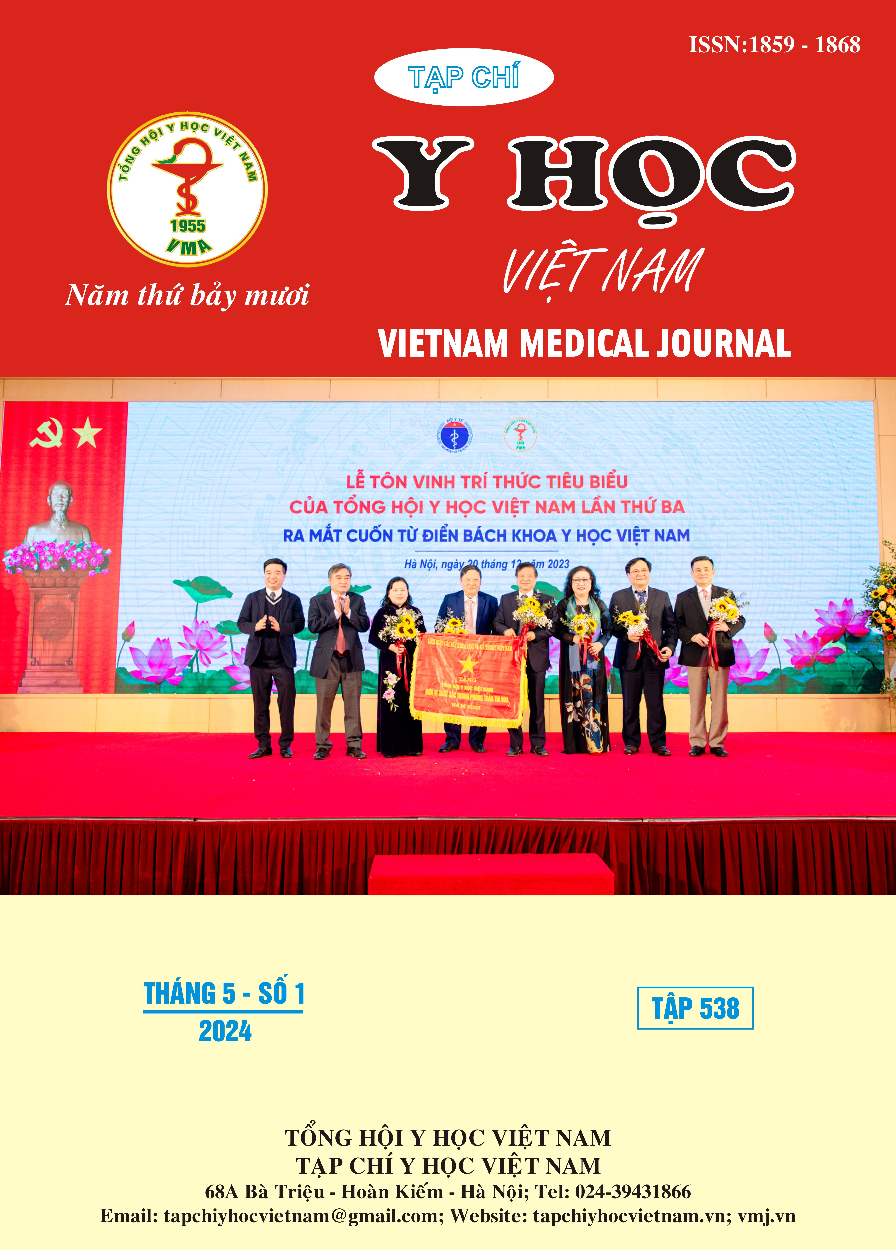ỨNG DỤNG THANG ĐIỂM S.T.O.N.E TRÊN CẮT LỚP VI TÍNH ĐA DÃY TRONG ĐÁNH GIÁ SỎI THẬN TRƯỚC TÁN SỎI
Nội dung chính của bài viết
Tóm tắt
Mục đích: Nghiên cứu nhằm ứng dụng thang điểm S.T.O.N.E trên cắt lớp vi tính (CLVT) đa dãy để đánh giá mức độ phức tạp của sỏi thận trước tán sỏi. Đối tượng và phương pháp: Nghiên cứu mô tả trên 71 bệnh nhân có sỏi thận, được chụp CLVT đa dãy hệ tiết niệu sau đó được tán sỏi tại Bệnh viện Đại học Y Hà Nội trong thời gian từ tháng 07/2022 đến tháng 07/2023. Các đặc điểm hình ảnh của sỏi thận trên CLVT không tiêm cản quang được phân loại theo thang điểm S.T.O.N.E nhằm đánh giá mức độ phức tạp của sỏi trước khi tán sỏi. Kết quả: Tuổi trung bình là 53,8± 12,3, thấp nhất là 31 tuổi, cao nhất là 73 tuổi. Tỷ lệ nam/nữ = 1,54. Theo thang điểm S.T.O.N.E, về diện tích sỏi (Stone Size), số lượng bệnh nhân có diện tích sỏi <400 mm2, từ 400 đến 799 mm2, từ 800 đến 1599 mm2 và ≥ 1600 mm2 lần lượt là 21 (chiếm 29,6%), 30 (chiếm 42,3%), 14 (chiếm 19,7%) và 6 (chiếm 8,5%). Về chiều dài đường hầm (Tract length, tính từ tâm sỏi đến bề mặt da), số bệnh nhân có chiều dài đường hầm <100 mm và >100 mm lần lượt là 62 (chiếm 87,3%) và 9 (chiếm 12,7%). Về tình trạng tắc nghẽn (Obstruction), số bệnh nhân không có hoặc giãn ứ nước thận nhẹ là 46 (chiếm 64,8%), có giãn ứ nước thận mức độ trung bình và nặng là 25 (chiếm 35,2%). Về số lượng các đài thận mang sỏi (Number of involved calices), số bệnh nhân có sỏi san hô, sỏi đài thận kết hợp bể thận, sỏi đài thận đơn thuần hoặc bể thận đơn thuần lần lượt là 10 (chiếm 14,1%), 37 (chiếm 52,1%) và 15 (chiếm 21,1%). Về tỷ trọng sỏi (Essence of stone density), số bệnh nhân có sỏi tỷ trọng <950 HU và ≥ 950 HU lần lượt là 9 (chiếm 12,7%) và 62 (chiếm 87,3%). Kết luận: Thang điểm S.T.O.N.E là một công cụ định lượng đơn giản, dễ thực hiện nhằm đánh giá mức độ phức tạp của sỏi thận, cần sử dụng trước tán sỏi.
Chi tiết bài viết
Từ khóa
Thang điểm STONE cắt lớp vi tính, tán sỏi, sỏi thận
Tài liệu tham khảo
2. Wen CC, Nakada SY (2007): Treatment selection and outcomes: renal calculi. Urol Clin North Am.; 34: 409-19.
3. de la Rosette J, Assimos D, et al. (2011). The Clinical Research Office of the Endourological Society Percutaneous Nephrolithotomy Global Study: Indications, complications, and outcomes in 5803 patients. J Endourol; 25:11‐7.
4. Mishra S, Sabnis RB, Desai M. Staghorn morphometry (2012): A new tool for clinical classification and prediction model for percutaneous nephrolithotomy monotherapy. J Endourol; 26:6‐14.
5. Kacker R, Zhao L, Macejko A, Thaxton CS, Stern J, Liu JJ, Nadler RB (2008): Radiographic parameters on noncontrast computerized tomography predictive of shock wave lithotripsy success. J Urol;179: 1866-71.
6. Okhunov Z, Friedlander JI, George AK, Duty BD, Moreira DM, Srinivasan AK, et al. (2013) S.T.O.N.E. nephrolithometry: Novel surgical classification system for kidney calculi. Urology; 81:1154‐9.
7. Macejko A, Okotie OT, Zhao LC, Liu J, Perry K, Nadler RB (2009): Computed tomography-determined stone-free rates for ureteroscopy of upper-tract stones. J Endourol.; 23: 379-82.
8. Takazawa R, Kitayama S, Tsujii T (2012): Successful outcome of flexible ureteroscopy with holmium laser lithotripsy for renal stones 2 cm or greater. Int J Urol.; 19: 264-7.
9. Bagley DH (2002): Expanding role of ureteroscopy and laser lithotripsy for treatment of proximal ureteral and intrarenal calculi. Curr Opin Urol.; 12: 277-80.
10. Hussain M, Acher P, Penev B, Cynk M (2011): Redefining the limits of flexible ureterorenoscopy. J Endourol; 25: 45-9.


